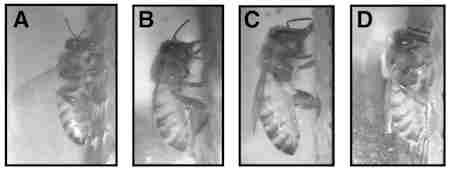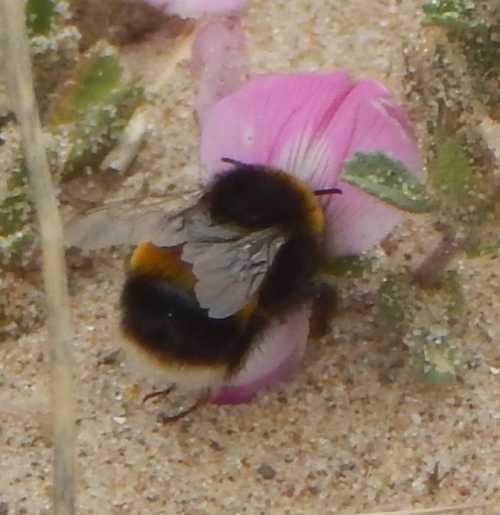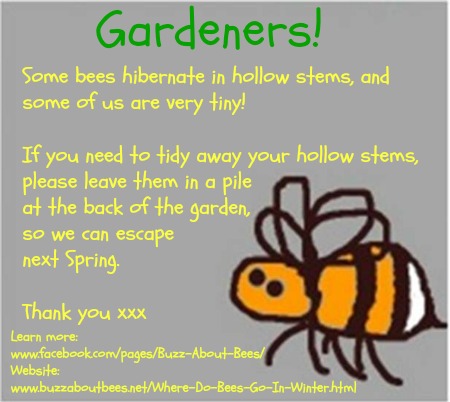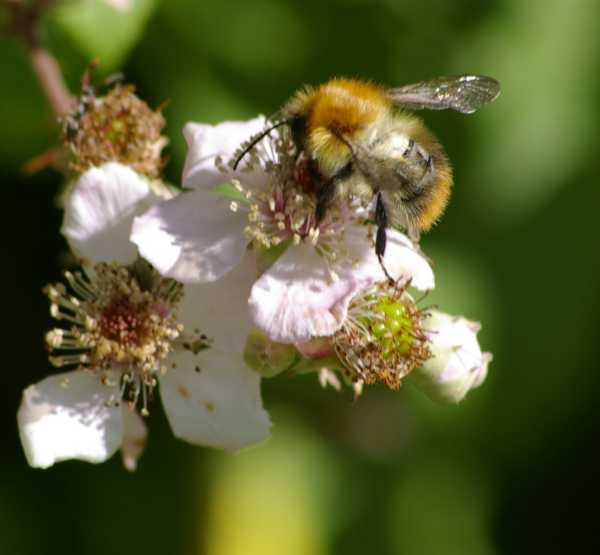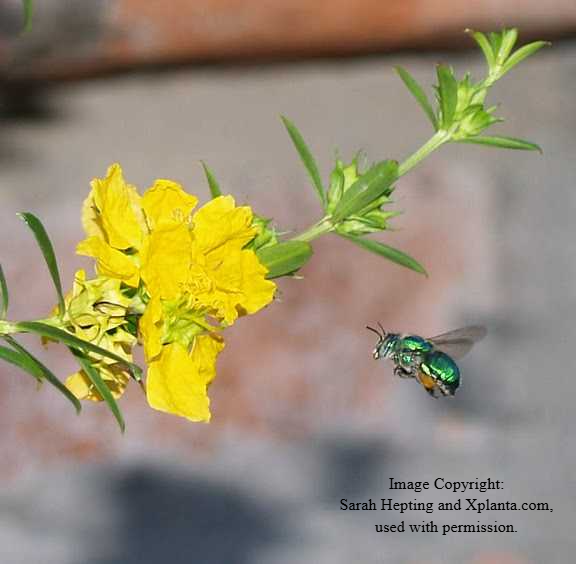Where Do Bees Go In Winter?
Updated: October 2023
What happens to bees when the weather grows cold? Where do bees live in winter? Do bees hibernate in winter, and how do they survive the low temperatures and stormy weather?
We may still see bees around in the autumn on dry days, feeding from the flowers on ivy - Hedera helix, and pollinating autumn raspberries (and other late crops). But what happens then?
Do bees hibernate? If so, where do bees hibernate?
It really depends on the species, but in summary:
- Bumble bee queens hibernate in winter. (The overwintering behaviour of bees, is sometimes more technically referred to as 'winter diapause').
- Most other wild bee species will overwinter in a birth cell, either as new, fully developed adults not yet emerged from their cells, or as pupae, waiting to complete their development.
- Honey bees overwinter in their hive or nest, forming a winter cluster around the queen, with the colony itself much reduced in size. They are less active though not entirely dormant, and the cluster 'shivers' to keep warm.
Given the many bee species in the world, there are of course, exceptions to those scenarios described above.
One key factor is climate: in exotic locations, species may be active throughout the year. In such circumstances, there remains sufficient abundance of the right kinds of foods to keep the bees active.
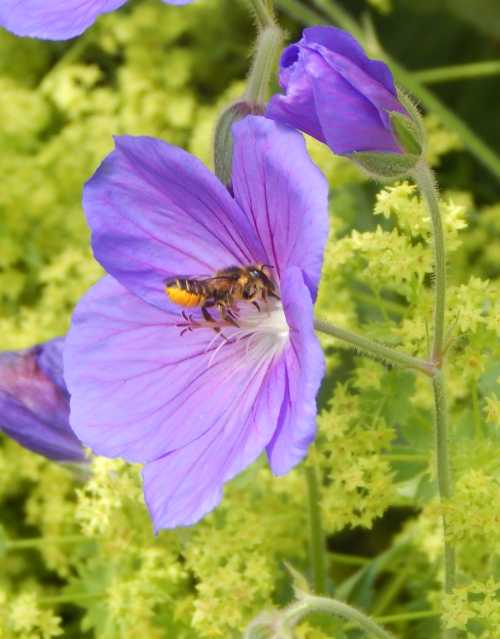 Leafcutter bee visiting geranium flower.
Leafcutter bee visiting geranium flower.Why do bees hibernate in winter?
In cooler climates (rather than exotic locations) where there are far fewer flowers from which to feed in the winter, bees need to shelter from the weather and conserve their energy until the flowers are blooming again.
Below we'll cover in turn, more detail about the winter habits of:
- bumble bees
- other wild bees
- honey bees
Where Do Bumble Bees Go In Winter?
Here is a nice little quote that sums up the situation for many wild bees, including bumble bees:
"The most common forms of overwintering in non-active bees involve either a prepupa or a fully developed, non-emerged adult within the birth cell. Eventually, rising temperature or some other physiological cue will trigger the bee to emerge.
Bumblebees are different in that the new queens produced in late summer feed up on flowers and then depart their birth nest, find an old rodent hole or some other pre-existing cavity (including compost heaps) and hibernate in this."
- Steven Falk - entomologist and author of Field Guide to Bees Of Great Britain And Ireland.
As autumn approaches, fewer species of bumble bee are seen
foraging. The natural lifecycle of bumble bees
means that most of the colony will die, and only the new bumble bee queens will
survive.
New queens will first mate with males, and importantly, feed to build up fat reserves ready for their winter snooze (hibernation).
Bumble bees do have a certain amount of tolerance for the cold, but could freeze at temperatures from around -7.1°C (see Can Bumble Bees Survive Cold Temperatures?).
Hibernation sites vary, but it seems most bumble bee species prefer soil banks (perhaps in an abandoned rodent hole) and slopes, and preferably in the shade or in a North West facing position (Goulson).
However, I have read reports of bumble bee quens being disturbed during their hibernation in soft potting compost in a plant pot, or in a pile of wooden logs.
They may also seek winter refuge in a compost heap or old pile of garden rubble and leaves.
Are changes in climate affecting hibernating patterns of bumble bees - such that we even witness winter active bumble bees?
In milder climates – and even in milder weather zones of countries such as the UK, bumble bees have been known to remain active through the winter, foraging on Mahonias or other late-winter blooming shrubs and flowers in public parks.
If winters are getting warmer, perhaps this should not surprise us.
But what about elsewhere?
In areas of South East Asia and South America, there are
bumble bee species that have no annual life cycle that includes winter hibernation, and colonies can become rather large as a result, even reaching up to several thousand workers (Michener & Laberge 1954; Michener Amir
1977).
In Brazil, the species Bombus incarum can produce as many as
2500 new males and queens in a single nest!
(In the UK, bumble bee colony size varies, but will perhaps reach 150 – 400 workers).
What about other wild bees?
In countries such as the UK, with its cool winters, some bees species (including solitary species - see bee sociality) may overwinter as mature adults, or as pupae.
Mining bees, such as the Ashy Mining bee, Andrena cineraria, remain underground as adults in their natal cells.
Some
species are very tiny and may overwinter in hollow plant stems. I encourage gardeners to leave the hollow plant stems until the following year, or if necessary, place the stems in a corner of the garden out of the way.
Interestingly, according to the book The Bees In Your Backyard: not
all the young of species develop and emerge from the nest in the same year, and will remain in the nest through multiple winters:
"Not all Habroda larvae from the previous year emerge: instead, some individuals will stay in the nest for 2 years and maybe longer; some bee species will delay emergence for 7 or even 10 years. Why all the bees from the previous year don't emerge together is not known, but it may have something to do with avoiding parasites, or even responding to rainfall cues."
Where Do Honey Bees Go In Winter?
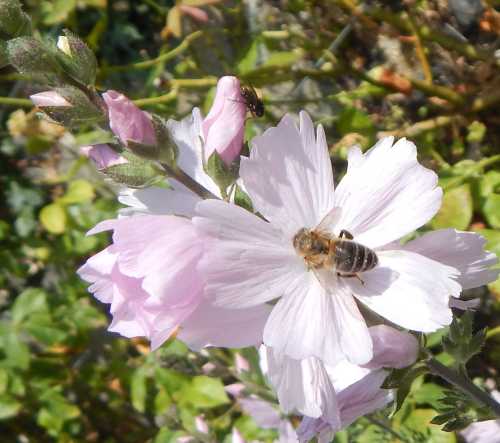 Honey bee foraging on prairie mallow.
Honey bee foraging on prairie mallow.In warmer climates, honey bees may be active all year, so that honey is essentially fuel for reproduction and swarming.
In cooler climates, honey bees become less active, but not entirely dormant (inactive), and honey (winter food stores) is vital to help sustain the colony.
When the temperature falls below 10 °C the honey bee queen and workers huddle together in their brood chamber, in a temperature regulating cluster called a 'thermo-regulating cluster.'
This is commonly referred to as a 'winter cluster'. By this time, there will be no males (drones) in the hive or nest.
Older worker bees will form the outside of the cluster, with the younger bees toward the middle. The clustering bees vibrate their wing muscles in a kind of shivering movement, which helps to generate heat.
The bees are also helped by their hairy bodies, because the fine hairs help to trap the heat, and this effect is magnified by the fact that there are lots of bees together, all with hairy bodies.
The colder it gets, the more tightly the bees form their cluster.
As younger worker bees in the middle of the cluster get warmer, they loosen the tightness of the cluster, allowing the warm air to circulate back to the older bees on the outer of the cluster. The outer temperature of the cluster is usually maintained at around 12 °C, but no less than 6 °C2.
Amazing fact:
Whilst honey bees shiver to keep warm during the winter, they create conditions that would be toxic to humans! Why?
As the bees are shivering, they use oxygen and exhale (breathe out) carbon dioxide. This is happening in an enclosed space.
In such an environment (carbon dioxide and restricted ventilation) humans could not survive, but the bees create such conditions intentionally because it decreases the bees' metabolic rate, and hence helps them to conserve their energy stores.
This higher level of carbon dioxide can also help to kill off some pests, such as the Varroa mite1!
Is the winter behaviour described above actually 'natural' in honey bees?
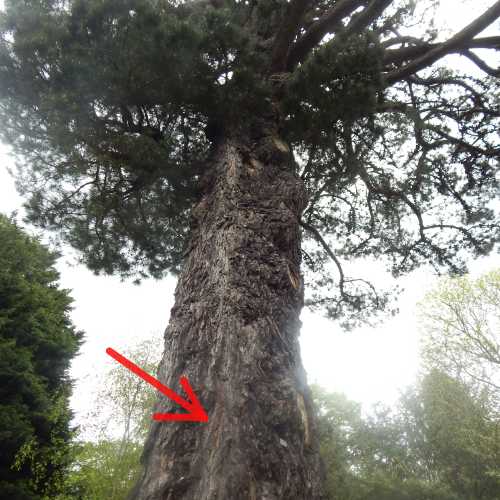 Wild honey bee nest in tree.
Wild honey bee nest in tree.In the wild, honey bees may be
more protected from the elements within the trunks of trees or caves, than they are in a man-made bee hive.
Indeed, some researchers are questioning whether what goes on in a honey bee hive in winter, reflects natural behaviour, or is simply a behaviour used by honey bees in order to cope with life in a man-made bee hive:
“Many honey bee behaviors previously thought to be intrinsic may only be a coping mechanism for human intervention; for example clustering in a tree enclosure may be an optional, rare, heat conservation behavior for established colonies, rather than the compulsory, frequent, life-saving behavior that is in the hives in common use.
The implied improved
survival in hives with thermal properties of tree nests may help to
solve some of the problems honey bees are currently facing in
apiculture.” - Researcher, Derek Mitchell 3.
Mitchell makes the point that in a natural bee cavity such as a tree
trunk, insulation is provided by the surrounding mass of the tree. (Indeed, I find it interesting that beekeepers of bygone years even used hollowed-out tree trunks in which to keep bees - see image below).
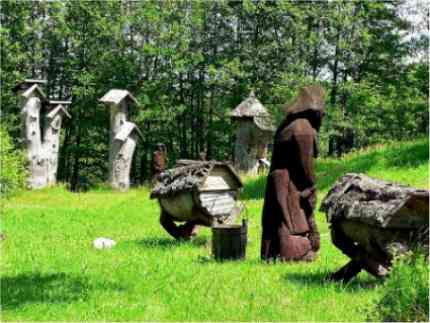 In some countries, beekeepers of bygone years even used hollowed-out tree trunks in which to keep bees. Image: Wikipedia
In some countries, beekeepers of bygone years even used hollowed-out tree trunks in which to keep bees. Image: WikipediaIn a tree cavity, there is a large amount of natural insulation provided by the trunk itself, both above and below the colony, that can be virtually any thickness, but more typically ranges from three to five inches, which is about six times the insulation quality of a typical bee box provided by the type of conventional beehive used today.
It should be noted that Mitchell used his background in physics to compare the heat loss from a tree to that of man-made bee hives.
He found that a man-made box from a conventional bee hive will lose four to seven times more heat than a typical tree colony, and that some behaviors of the colony may even be driven by that fact!
References:
(1) The Potential of Bee-Generated Carbon Dioxide for Control of Varroa Mite (Mesostigmata: Varroidae) in Indoor Overwintering Honey bee (Hymenoptera: Apidae) Colonies Rassol Bahreini and Robert W. Currie Journal of Economic Entomology 2015 108(5), 2153-2167
(2) Phillips EF, Demuth GS: Temperature of the honeybee cluster in winter. Bull US Dept Agric 1914, 93:1-16.
(3) Ratios of colony mass to thermal conductance of tree and man-made
nest enclosures of Apis mellifera: implications for survival,
clustering, humidity regulation and Varroa destructor Derek Mitchell
Published online 2015
Do bees sleep?
Apparently they do, but how do we know?
